F11C - Unit 14: Advanced Management Accounting - AMA1 Report
VerifiedAdded on 2021/03/25
|25
|5572
|389
Report
AI Summary
This report, prepared by a student, analyzes key financial statements including the balance sheet, income statement, and cash flow statement. It examines these statements from the perspective of different stakeholders, such as investors, creditors, and the government, highlighting the information each seeks and the ratios used for evaluation. The report details the components of each statement, including assets, liabilities, equity, revenue, expenses, and the various activities impacting cash flow. It also discusses the benefits of each statement for users, such as investors and creditors, and how they inform financial planning and decision-making. Furthermore, the report addresses how the financial statements are used to determine profitability, liquidity, and the ability to meet financial obligations. The report also provides an overview of the uses of management accounting techniques to support organizational performance.
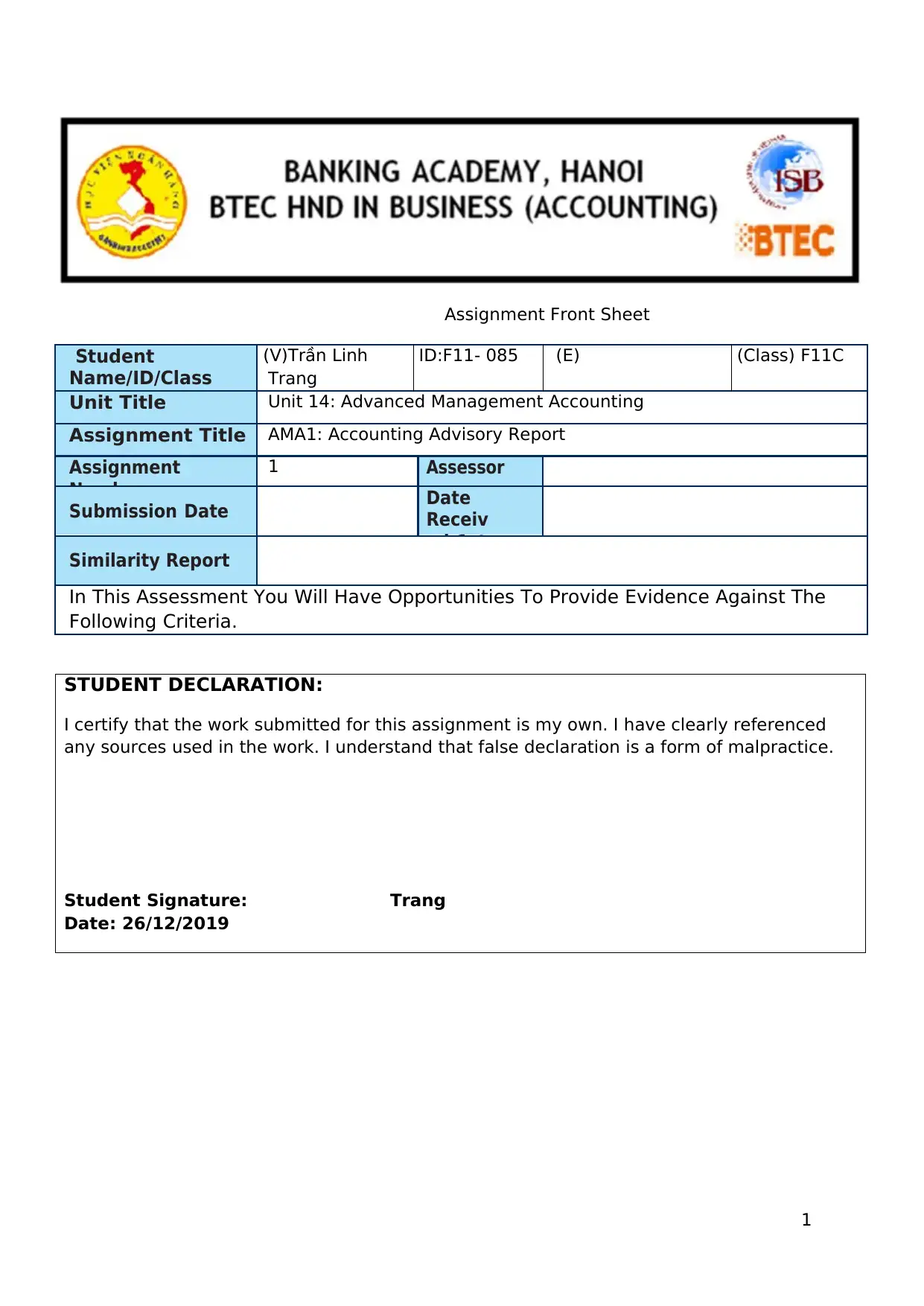
Assignment Front Sheet
Student
Name/ID/Class
(V)Trần Linh
Trang
ID:F11- 085 (E) (Class) F11C
Unit Title Unit 14: Advanced Management Accounting
Assignment Title AMA1: Accounting Advisory Report
Assignment
Number
1 Assessor
Submission Date Date
Receiv
ed 1st
Similarity Report
In This Assessment You Will Have Opportunities To Provide Evidence Against The
Following Criteria.
Indicate The Page Numbers Where The Evidence Can Be Found
STUDENT DECLARATION:
I certify that the work submitted for this assignment is my own. I have clearly referenced
any sources used in the work. I understand that false declaration is a form of malpractice.
Student Signature: Trang
Date: 26/12/2019
1
Student
Name/ID/Class
(V)Trần Linh
Trang
ID:F11- 085 (E) (Class) F11C
Unit Title Unit 14: Advanced Management Accounting
Assignment Title AMA1: Accounting Advisory Report
Assignment
Number
1 Assessor
Submission Date Date
Receiv
ed 1st
Similarity Report
In This Assessment You Will Have Opportunities To Provide Evidence Against The
Following Criteria.
Indicate The Page Numbers Where The Evidence Can Be Found
STUDENT DECLARATION:
I certify that the work submitted for this assignment is my own. I have clearly referenced
any sources used in the work. I understand that false declaration is a form of malpractice.
Student Signature: Trang
Date: 26/12/2019
1
Paraphrase This Document
Need a fresh take? Get an instant paraphrase of this document with our AI Paraphraser
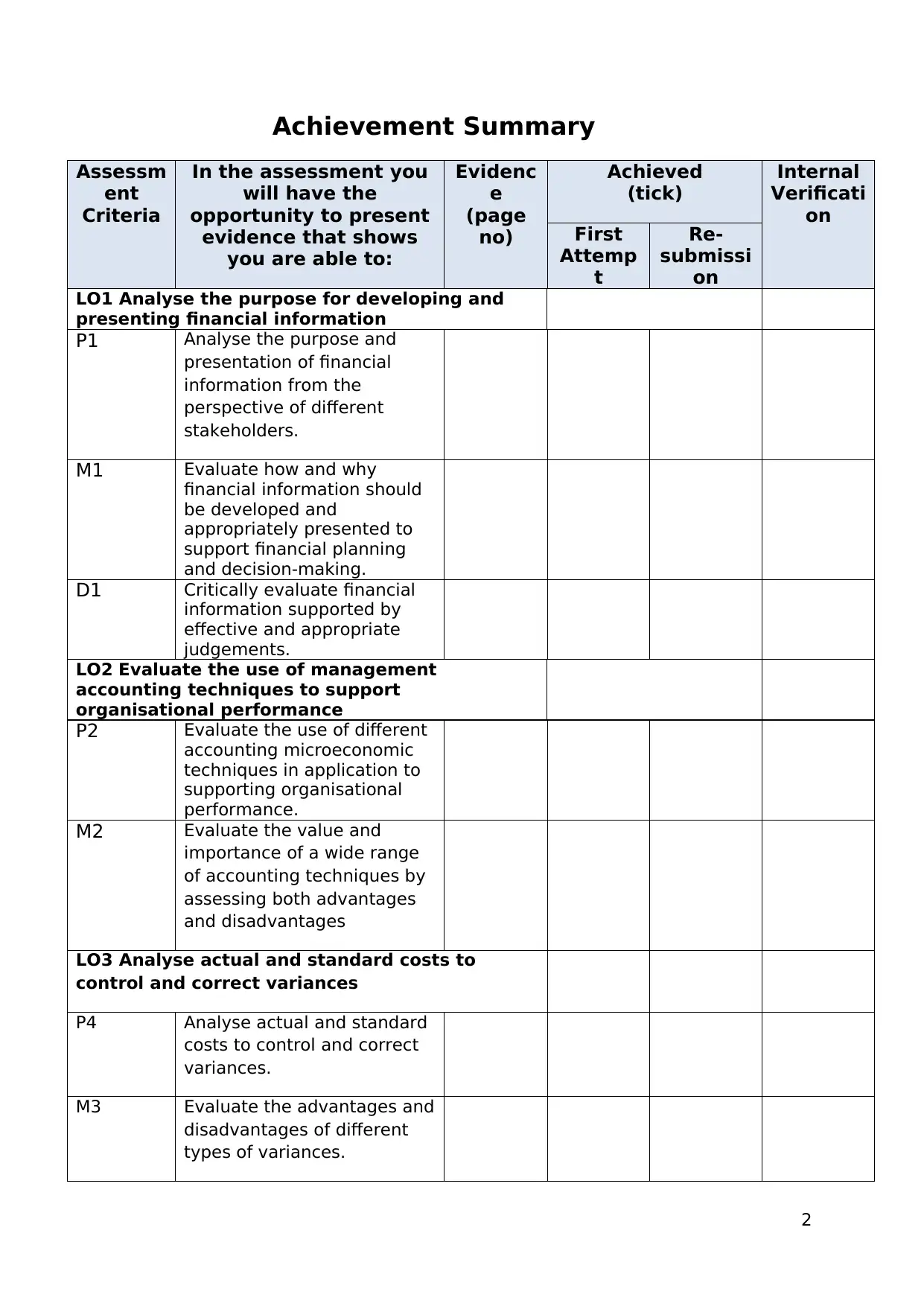
Achievement Summary
Assessm
ent
Criteria
In the assessment you
will have the
opportunity to present
evidence that shows
you are able to:
Evidenc
e
(page
no)
Achieved
(tick)
Internal
Verificati
on
First
Attemp
t
Re-
submissi
on
LO1 Analyse the purpose for developing and
presenting financial information
P1 Analyse the purpose and
presentation of financial
information from the
perspective of different
stakeholders.
M1 Evaluate how and why
financial information should
be developed and
appropriately presented to
support financial planning
and decision-making.
D1 Critically evaluate financial
information supported by
effective and appropriate
judgements.
LO2 Evaluate the use of management
accounting techniques to support
organisational performance
P2 Evaluate the use of different
accounting microeconomic
techniques in application to
supporting organisational
performance.
M2 Evaluate the value and
importance of a wide range
of accounting techniques by
assessing both advantages
and disadvantages
LO3 Analyse actual and standard costs to
control and correct variances
P4 Analyse actual and standard
costs to control and correct
variances.
M3 Evaluate the advantages and
disadvantages of different
types of variances.
2
Assessm
ent
Criteria
In the assessment you
will have the
opportunity to present
evidence that shows
you are able to:
Evidenc
e
(page
no)
Achieved
(tick)
Internal
Verificati
on
First
Attemp
t
Re-
submissi
on
LO1 Analyse the purpose for developing and
presenting financial information
P1 Analyse the purpose and
presentation of financial
information from the
perspective of different
stakeholders.
M1 Evaluate how and why
financial information should
be developed and
appropriately presented to
support financial planning
and decision-making.
D1 Critically evaluate financial
information supported by
effective and appropriate
judgements.
LO2 Evaluate the use of management
accounting techniques to support
organisational performance
P2 Evaluate the use of different
accounting microeconomic
techniques in application to
supporting organisational
performance.
M2 Evaluate the value and
importance of a wide range
of accounting techniques by
assessing both advantages
and disadvantages
LO3 Analyse actual and standard costs to
control and correct variances
P4 Analyse actual and standard
costs to control and correct
variances.
M3 Evaluate the advantages and
disadvantages of different
types of variances.
2
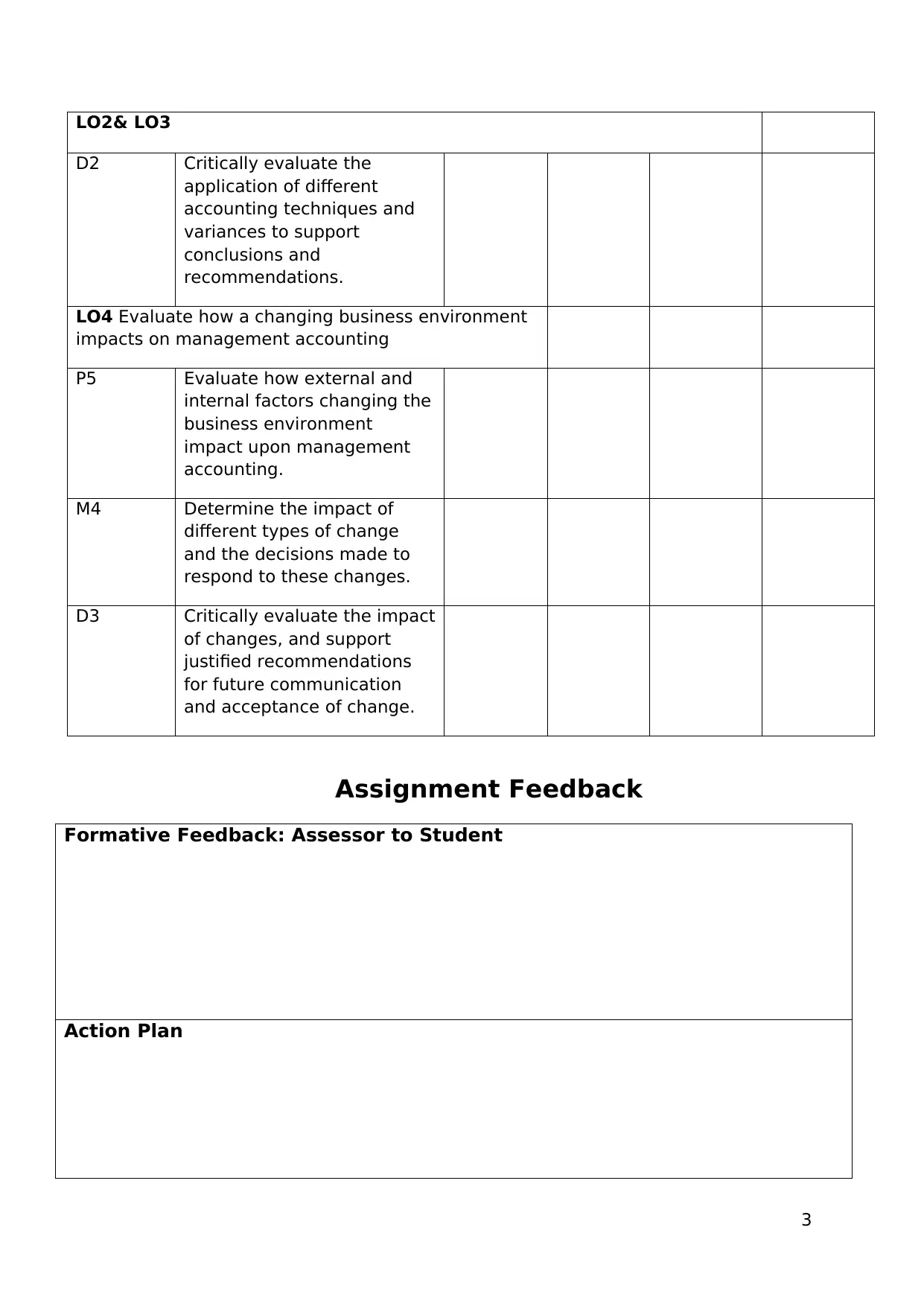
LO2& LO3
D2 Critically evaluate the
application of different
accounting techniques and
variances to support
conclusions and
recommendations.
LO4 Evaluate how a changing business environment
impacts on management accounting
P5 Evaluate how external and
internal factors changing the
business environment
impact upon management
accounting.
M4 Determine the impact of
different types of change
and the decisions made to
respond to these changes.
D3 Critically evaluate the impact
of changes, and support
justified recommendations
for future communication
and acceptance of change.
Assignment Feedback
Formative Feedback: Assessor to Student
Action Plan
3
D2 Critically evaluate the
application of different
accounting techniques and
variances to support
conclusions and
recommendations.
LO4 Evaluate how a changing business environment
impacts on management accounting
P5 Evaluate how external and
internal factors changing the
business environment
impact upon management
accounting.
M4 Determine the impact of
different types of change
and the decisions made to
respond to these changes.
D3 Critically evaluate the impact
of changes, and support
justified recommendations
for future communication
and acceptance of change.
Assignment Feedback
Formative Feedback: Assessor to Student
Action Plan
3
⊘ This is a preview!⊘
Do you want full access?
Subscribe today to unlock all pages.

Trusted by 1+ million students worldwide
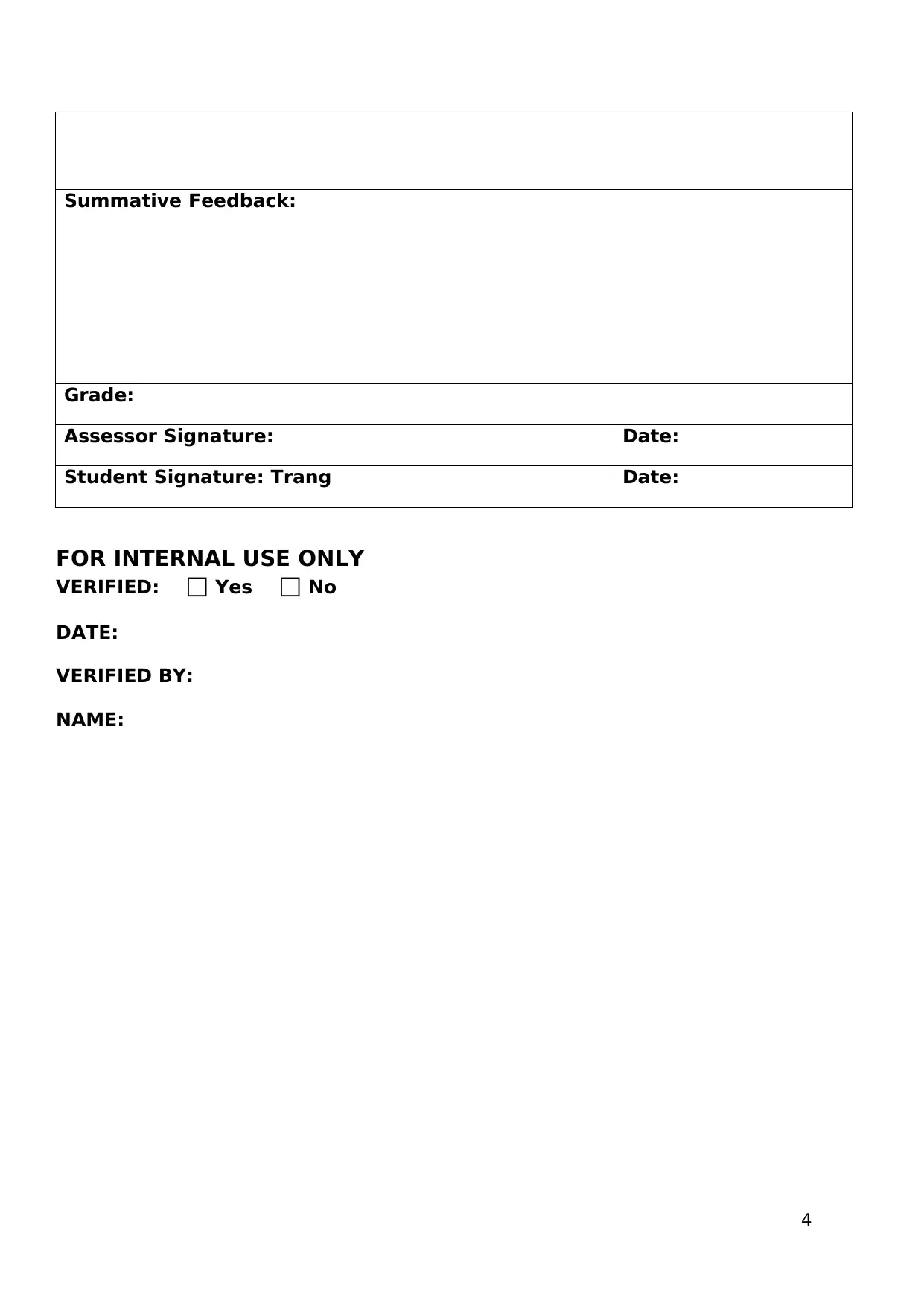
Summative Feedback:
Grade:
Assessor Signature: Date:
Student Signature: Trang Date:
FOR INTERNAL USE ONLY
VERIFIED: □ Yes □ No
DATE:
VERIFIED BY:
NAME:
4
Grade:
Assessor Signature: Date:
Student Signature: Trang Date:
FOR INTERNAL USE ONLY
VERIFIED: □ Yes □ No
DATE:
VERIFIED BY:
NAME:
4
Paraphrase This Document
Need a fresh take? Get an instant paraphrase of this document with our AI Paraphraser
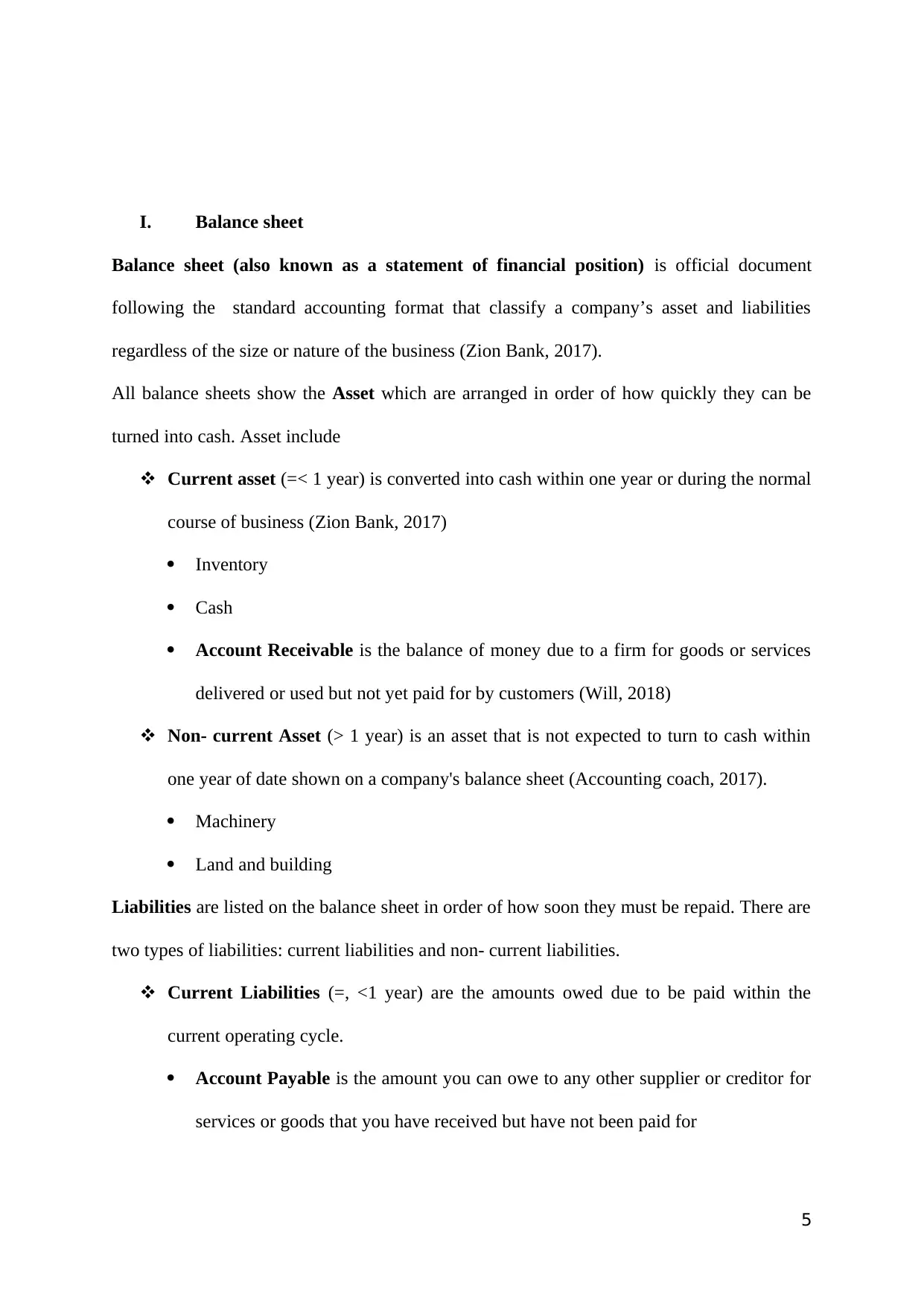
I. Balance sheet
Balance sheet (also known as a statement of financial position) is official document
following the standard accounting format that classify a company’s asset and liabilities
regardless of the size or nature of the business (Zion Bank, 2017).
All balance sheets show the Asset which are arranged in order of how quickly they can be
turned into cash. Asset include
Current asset (=< 1 year) is converted into cash within one year or during the normal
course of business (Zion Bank, 2017)
Inventory
Cash
Account Receivable is the balance of money due to a firm for goods or services
delivered or used but not yet paid for by customers (Will, 2018)
Non- current Asset (> 1 year) is an asset that is not expected to turn to cash within
one year of date shown on a company's balance sheet (Accounting coach, 2017).
Machinery
Land and building
Liabilities are listed on the balance sheet in order of how soon they must be repaid. There are
two types of liabilities: current liabilities and non- current liabilities.
Current Liabilities (=, <1 year) are the amounts owed due to be paid within the
current operating cycle.
Account Payable is the amount you can owe to any other supplier or creditor for
services or goods that you have received but have not been paid for
5
Balance sheet (also known as a statement of financial position) is official document
following the standard accounting format that classify a company’s asset and liabilities
regardless of the size or nature of the business (Zion Bank, 2017).
All balance sheets show the Asset which are arranged in order of how quickly they can be
turned into cash. Asset include
Current asset (=< 1 year) is converted into cash within one year or during the normal
course of business (Zion Bank, 2017)
Inventory
Cash
Account Receivable is the balance of money due to a firm for goods or services
delivered or used but not yet paid for by customers (Will, 2018)
Non- current Asset (> 1 year) is an asset that is not expected to turn to cash within
one year of date shown on a company's balance sheet (Accounting coach, 2017).
Machinery
Land and building
Liabilities are listed on the balance sheet in order of how soon they must be repaid. There are
two types of liabilities: current liabilities and non- current liabilities.
Current Liabilities (=, <1 year) are the amounts owed due to be paid within the
current operating cycle.
Account Payable is the amount you can owe to any other supplier or creditor for
services or goods that you have received but have not been paid for
5
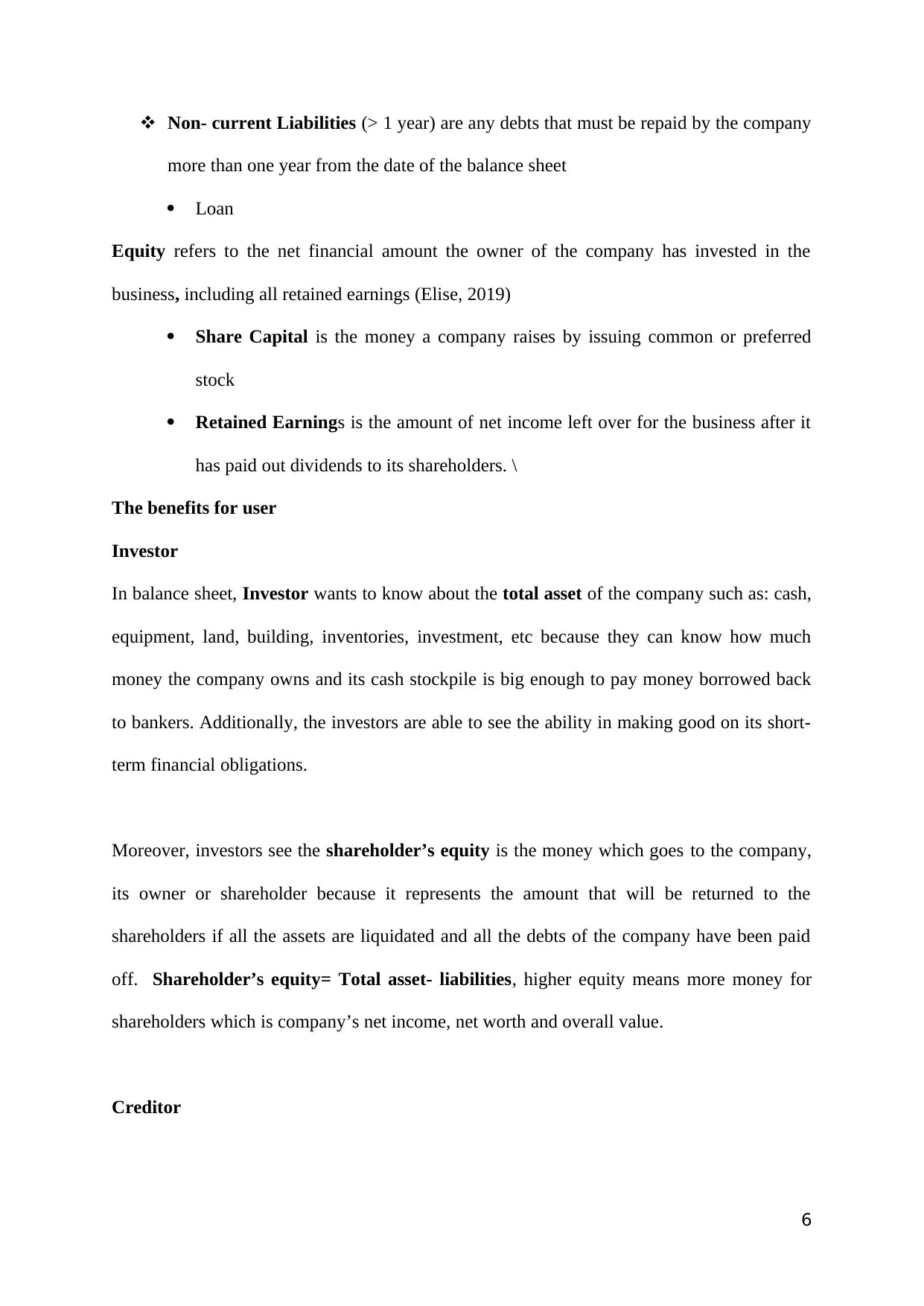
Non- current Liabilities (> 1 year) are any debts that must be repaid by the company
more than one year from the date of the balance sheet
Loan
Equity refers to the net financial amount the owner of the company has invested in the
business, including all retained earnings (Elise, 2019)
Share Capital is the money a company raises by issuing common or preferred
stock
Retained Earnings is the amount of net income left over for the business after it
has paid out dividends to its shareholders. \
The benefits for user
Investor
In balance sheet, Investor wants to know about the total asset of the company such as: cash,
equipment, land, building, inventories, investment, etc because they can know how much
money the company owns and its cash stockpile is big enough to pay money borrowed back
to bankers. Additionally, the investors are able to see the ability in making good on its short-
term financial obligations.
Moreover, investors see the shareholder’s equity is the money which goes to the company,
its owner or shareholder because it represents the amount that will be returned to the
shareholders if all the assets are liquidated and all the debts of the company have been paid
off. Shareholder’s equity= Total asset- liabilities, higher equity means more money for
shareholders which is company’s net income, net worth and overall value.
Creditor
6
more than one year from the date of the balance sheet
Loan
Equity refers to the net financial amount the owner of the company has invested in the
business, including all retained earnings (Elise, 2019)
Share Capital is the money a company raises by issuing common or preferred
stock
Retained Earnings is the amount of net income left over for the business after it
has paid out dividends to its shareholders. \
The benefits for user
Investor
In balance sheet, Investor wants to know about the total asset of the company such as: cash,
equipment, land, building, inventories, investment, etc because they can know how much
money the company owns and its cash stockpile is big enough to pay money borrowed back
to bankers. Additionally, the investors are able to see the ability in making good on its short-
term financial obligations.
Moreover, investors see the shareholder’s equity is the money which goes to the company,
its owner or shareholder because it represents the amount that will be returned to the
shareholders if all the assets are liquidated and all the debts of the company have been paid
off. Shareholder’s equity= Total asset- liabilities, higher equity means more money for
shareholders which is company’s net income, net worth and overall value.
Creditor
6
⊘ This is a preview!⊘
Do you want full access?
Subscribe today to unlock all pages.

Trusted by 1+ million students worldwide
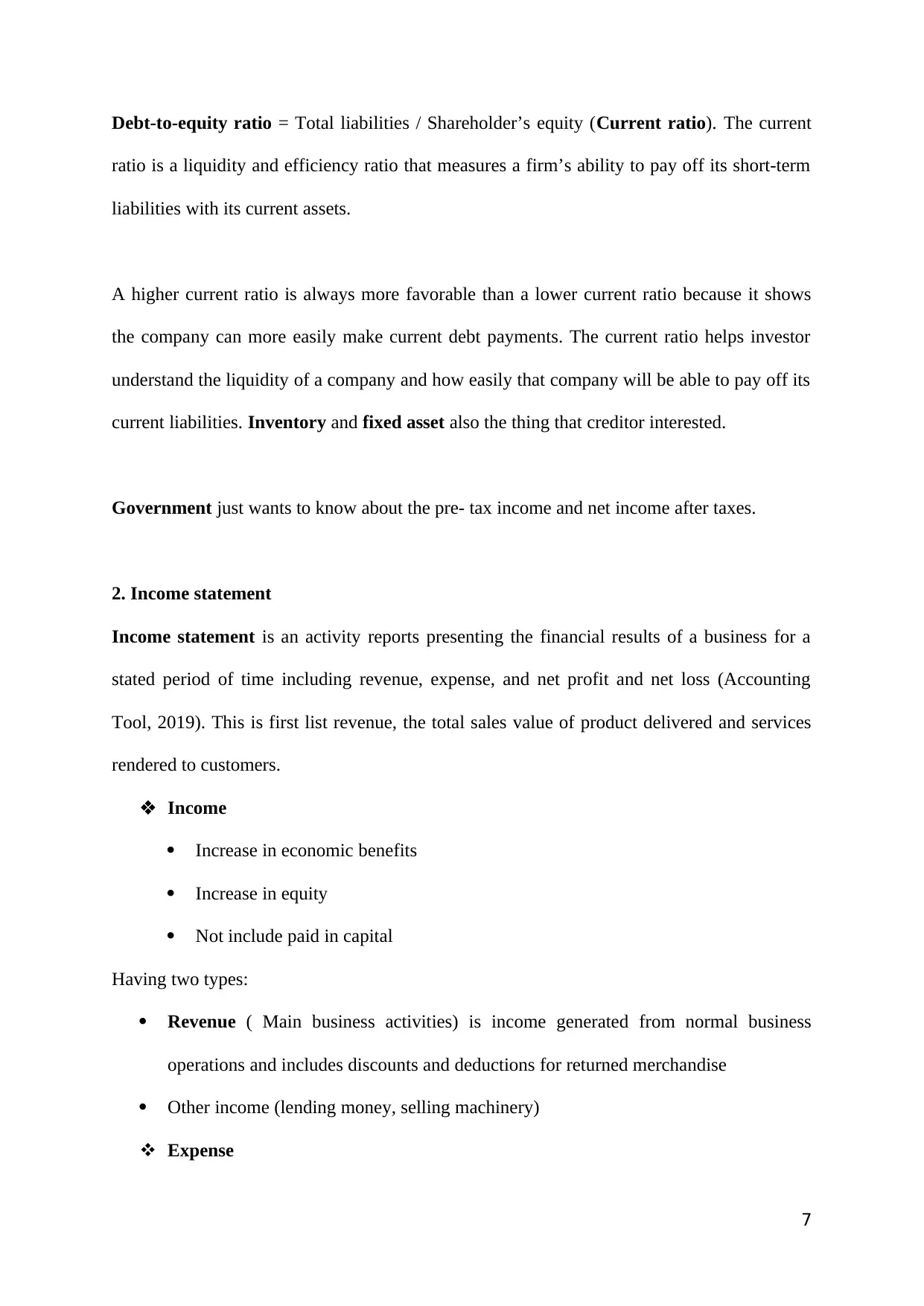
Debt-to-equity ratio = Total liabilities / Shareholder’s equity (Current ratio). The current
ratio is a liquidity and efficiency ratio that measures a firm’s ability to pay off its short-term
liabilities with its current assets.
A higher current ratio is always more favorable than a lower current ratio because it shows
the company can more easily make current debt payments. The current ratio helps investor
understand the liquidity of a company and how easily that company will be able to pay off its
current liabilities. Inventory and fixed asset also the thing that creditor interested.
Government just wants to know about the pre- tax income and net income after taxes.
2. Income statement
Income statement is an activity reports presenting the financial results of a business for a
stated period of time including revenue, expense, and net profit and net loss (Accounting
Tool, 2019). This is first list revenue, the total sales value of product delivered and services
rendered to customers.
Income
Increase in economic benefits
Increase in equity
Not include paid in capital
Having two types:
Revenue ( Main business activities) is income generated from normal business
operations and includes discounts and deductions for returned merchandise
Other income (lending money, selling machinery)
Expense
7
ratio is a liquidity and efficiency ratio that measures a firm’s ability to pay off its short-term
liabilities with its current assets.
A higher current ratio is always more favorable than a lower current ratio because it shows
the company can more easily make current debt payments. The current ratio helps investor
understand the liquidity of a company and how easily that company will be able to pay off its
current liabilities. Inventory and fixed asset also the thing that creditor interested.
Government just wants to know about the pre- tax income and net income after taxes.
2. Income statement
Income statement is an activity reports presenting the financial results of a business for a
stated period of time including revenue, expense, and net profit and net loss (Accounting
Tool, 2019). This is first list revenue, the total sales value of product delivered and services
rendered to customers.
Income
Increase in economic benefits
Increase in equity
Not include paid in capital
Having two types:
Revenue ( Main business activities) is income generated from normal business
operations and includes discounts and deductions for returned merchandise
Other income (lending money, selling machinery)
Expense
7
Paraphrase This Document
Need a fresh take? Get an instant paraphrase of this document with our AI Paraphraser
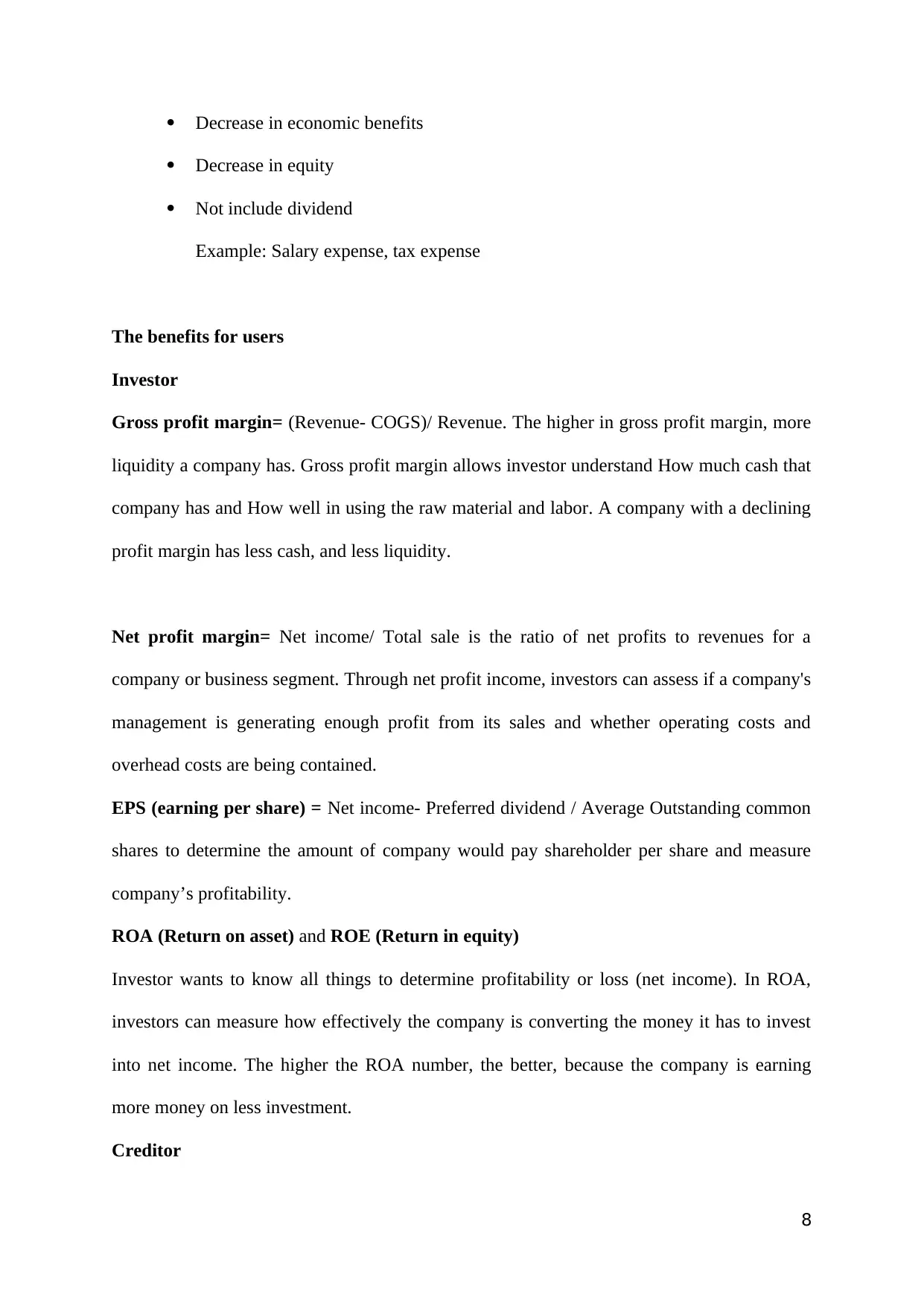
Decrease in economic benefits
Decrease in equity
Not include dividend
Example: Salary expense, tax expense
The benefits for users
Investor
Gross profit margin= (Revenue- COGS)/ Revenue. The higher in gross profit margin, more
liquidity a company has. Gross profit margin allows investor understand How much cash that
company has and How well in using the raw material and labor. A company with a declining
profit margin has less cash, and less liquidity.
Net profit margin= Net income/ Total sale is the ratio of net profits to revenues for a
company or business segment. Through net profit income, investors can assess if a company's
management is generating enough profit from its sales and whether operating costs and
overhead costs are being contained.
EPS (earning per share) = Net income- Preferred dividend / Average Outstanding common
shares to determine the amount of company would pay shareholder per share and measure
company’s profitability.
ROA (Return on asset) and ROE (Return in equity)
Investor wants to know all things to determine profitability or loss (net income). In ROA,
investors can measure how effectively the company is converting the money it has to invest
into net income. The higher the ROA number, the better, because the company is earning
more money on less investment.
Creditor
8
Decrease in equity
Not include dividend
Example: Salary expense, tax expense
The benefits for users
Investor
Gross profit margin= (Revenue- COGS)/ Revenue. The higher in gross profit margin, more
liquidity a company has. Gross profit margin allows investor understand How much cash that
company has and How well in using the raw material and labor. A company with a declining
profit margin has less cash, and less liquidity.
Net profit margin= Net income/ Total sale is the ratio of net profits to revenues for a
company or business segment. Through net profit income, investors can assess if a company's
management is generating enough profit from its sales and whether operating costs and
overhead costs are being contained.
EPS (earning per share) = Net income- Preferred dividend / Average Outstanding common
shares to determine the amount of company would pay shareholder per share and measure
company’s profitability.
ROA (Return on asset) and ROE (Return in equity)
Investor wants to know all things to determine profitability or loss (net income). In ROA,
investors can measure how effectively the company is converting the money it has to invest
into net income. The higher the ROA number, the better, because the company is earning
more money on less investment.
Creditor
8
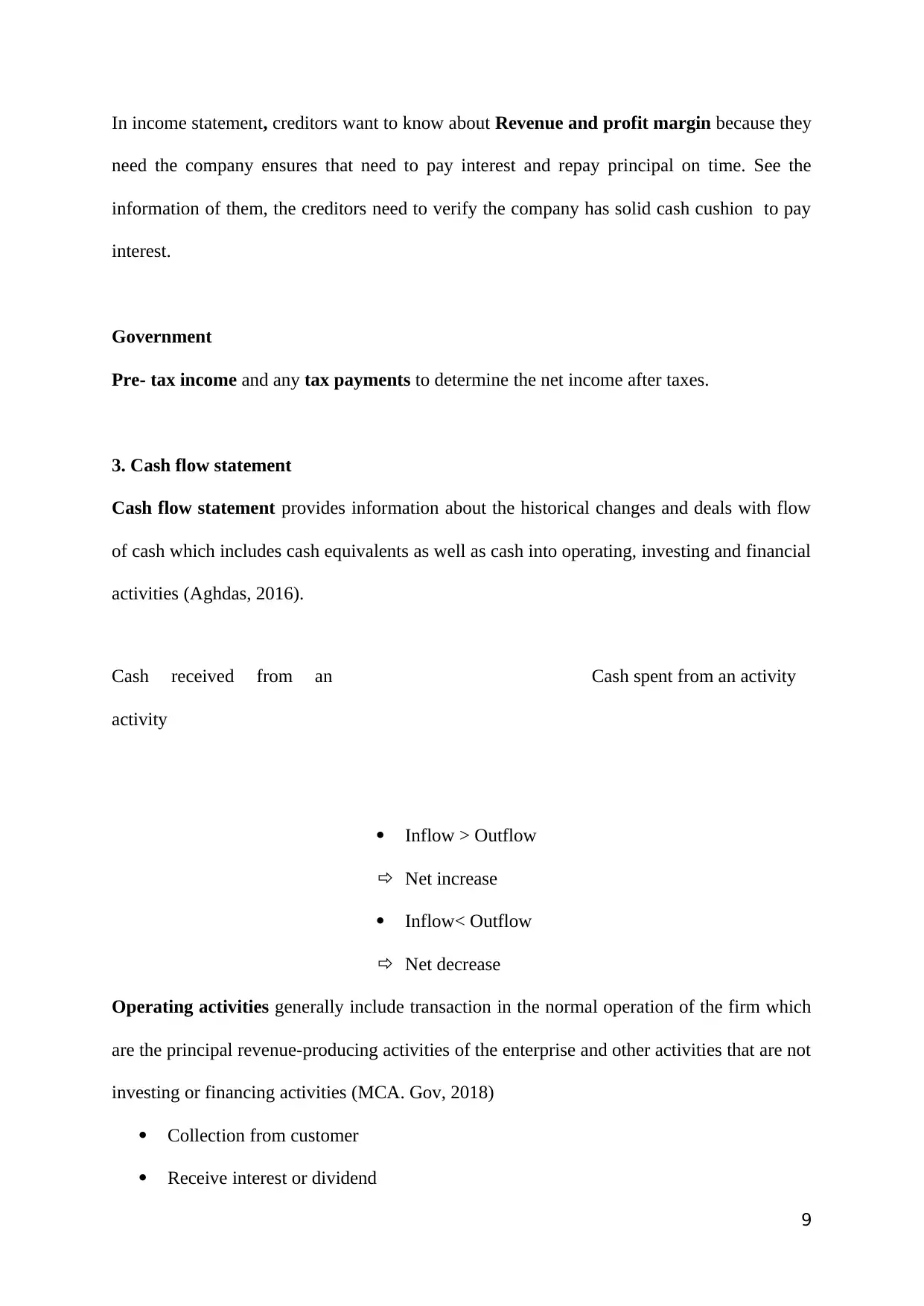
In income statement, creditors want to know about Revenue and profit margin because they
need the company ensures that need to pay interest and repay principal on time. See the
information of them, the creditors need to verify the company has solid cash cushion to pay
interest.
Government
Pre- tax income and any tax payments to determine the net income after taxes.
3. Cash flow statement
Cash flow statement provides information about the historical changes and deals with flow
of cash which includes cash equivalents as well as cash into operating, investing and financial
activities (Aghdas, 2016).
Cash received from an
activity
Cash spent from an activity
Inflow > Outflow
Net increase
Inflow< Outflow
Net decrease
Operating activities generally include transaction in the normal operation of the firm which
are the principal revenue-producing activities of the enterprise and other activities that are not
investing or financing activities (MCA. Gov, 2018)
Collection from customer
Receive interest or dividend
9
need the company ensures that need to pay interest and repay principal on time. See the
information of them, the creditors need to verify the company has solid cash cushion to pay
interest.
Government
Pre- tax income and any tax payments to determine the net income after taxes.
3. Cash flow statement
Cash flow statement provides information about the historical changes and deals with flow
of cash which includes cash equivalents as well as cash into operating, investing and financial
activities (Aghdas, 2016).
Cash received from an
activity
Cash spent from an activity
Inflow > Outflow
Net increase
Inflow< Outflow
Net decrease
Operating activities generally include transaction in the normal operation of the firm which
are the principal revenue-producing activities of the enterprise and other activities that are not
investing or financing activities (MCA. Gov, 2018)
Collection from customer
Receive interest or dividend
9
⊘ This is a preview!⊘
Do you want full access?
Subscribe today to unlock all pages.

Trusted by 1+ million students worldwide
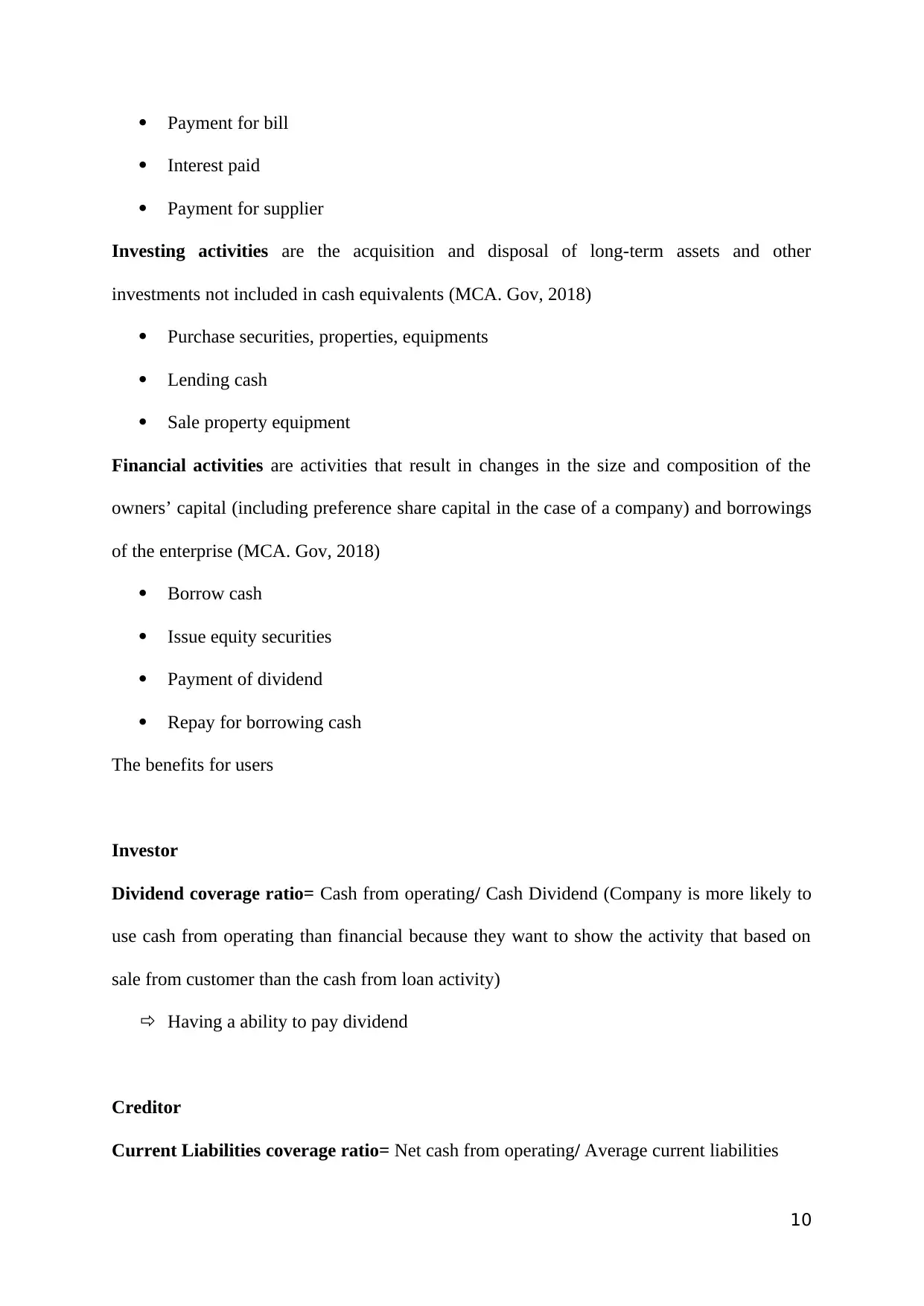
Payment for bill
Interest paid
Payment for supplier
Investing activities are the acquisition and disposal of long-term assets and other
investments not included in cash equivalents (MCA. Gov, 2018)
Purchase securities, properties, equipments
Lending cash
Sale property equipment
Financial activities are activities that result in changes in the size and composition of the
owners’ capital (including preference share capital in the case of a company) and borrowings
of the enterprise (MCA. Gov, 2018)
Borrow cash
Issue equity securities
Payment of dividend
Repay for borrowing cash
The benefits for users
Investor
Dividend coverage ratio= Cash from operating/ Cash Dividend (Company is more likely to
use cash from operating than financial because they want to show the activity that based on
sale from customer than the cash from loan activity)
Having a ability to pay dividend
Creditor
Current Liabilities coverage ratio= Net cash from operating/ Average current liabilities
10
Interest paid
Payment for supplier
Investing activities are the acquisition and disposal of long-term assets and other
investments not included in cash equivalents (MCA. Gov, 2018)
Purchase securities, properties, equipments
Lending cash
Sale property equipment
Financial activities are activities that result in changes in the size and composition of the
owners’ capital (including preference share capital in the case of a company) and borrowings
of the enterprise (MCA. Gov, 2018)
Borrow cash
Issue equity securities
Payment of dividend
Repay for borrowing cash
The benefits for users
Investor
Dividend coverage ratio= Cash from operating/ Cash Dividend (Company is more likely to
use cash from operating than financial because they want to show the activity that based on
sale from customer than the cash from loan activity)
Having a ability to pay dividend
Creditor
Current Liabilities coverage ratio= Net cash from operating/ Average current liabilities
10
Paraphrase This Document
Need a fresh take? Get an instant paraphrase of this document with our AI Paraphraser
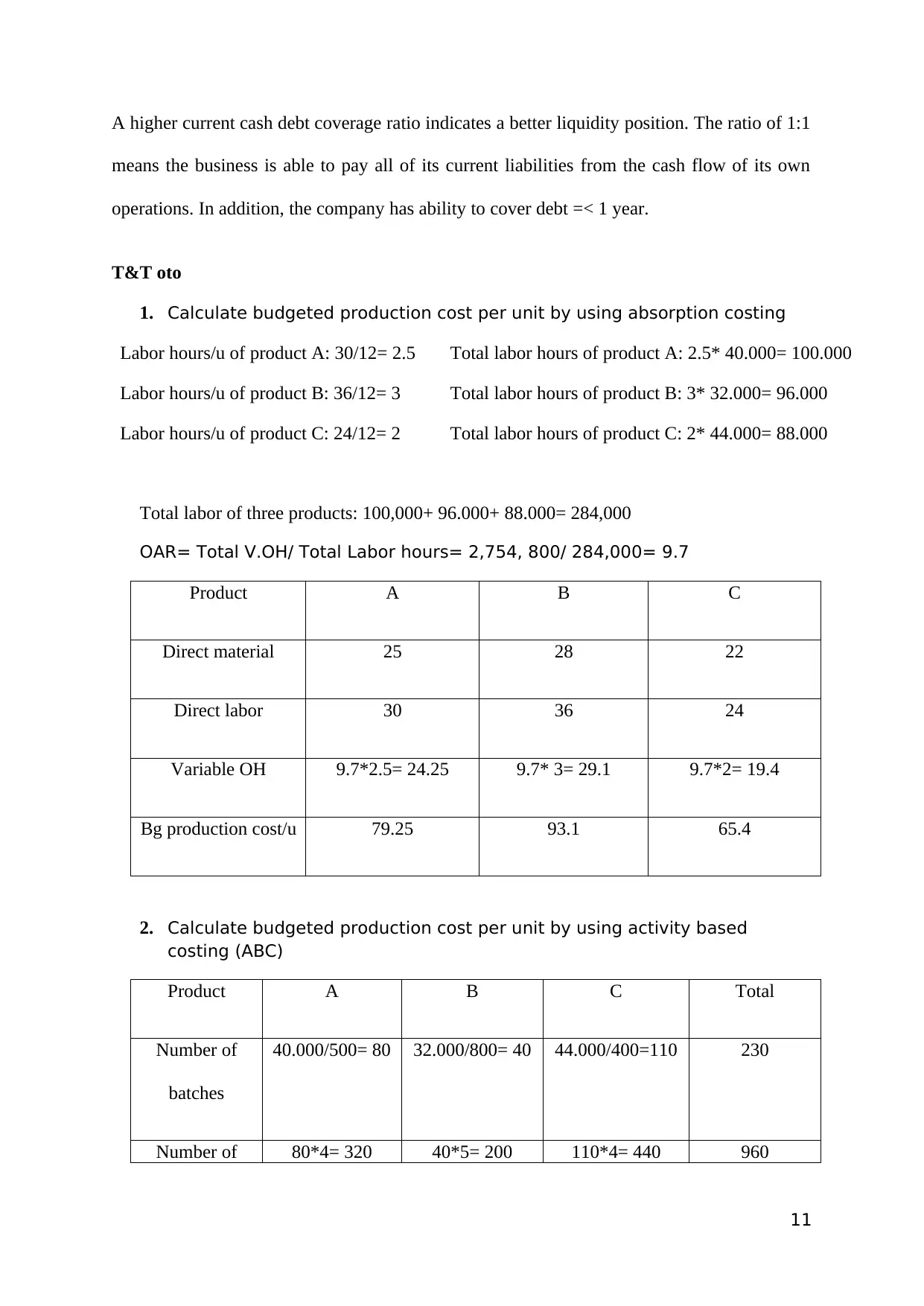
A higher current cash debt coverage ratio indicates a better liquidity position. The ratio of 1:1
means the business is able to pay all of its current liabilities from the cash flow of its own
operations. In addition, the company has ability to cover debt =< 1 year.
T&T oto
1. Calculate budgeted production cost per unit by using absorption costing
Labor hours/u of product A: 30/12= 2.5 Total labor hours of product A: 2.5* 40.000= 100.000
Labor hours/u of product B: 36/12= 3 Total labor hours of product B: 3* 32.000= 96.000
Labor hours/u of product C: 24/12= 2 Total labor hours of product C: 2* 44.000= 88.000
Total labor of three products: 100,000+ 96.000+ 88.000= 284,000
OAR= Total V.OH/ Total Labor hours= 2,754, 800/ 284,000= 9.7
Product A B C
Direct material 25 28 22
Direct labor 30 36 24
Variable OH 9.7*2.5= 24.25 9.7* 3= 29.1 9.7*2= 19.4
Bg production cost/u 79.25 93.1 65.4
2. Calculate budgeted production cost per unit by using activity based
costing (ABC)
Product A B C Total
Number of
batches
40.000/500= 80 32.000/800= 40 44.000/400=110 230
Number of 80*4= 320 40*5= 200 110*4= 440 960
11
means the business is able to pay all of its current liabilities from the cash flow of its own
operations. In addition, the company has ability to cover debt =< 1 year.
T&T oto
1. Calculate budgeted production cost per unit by using absorption costing
Labor hours/u of product A: 30/12= 2.5 Total labor hours of product A: 2.5* 40.000= 100.000
Labor hours/u of product B: 36/12= 3 Total labor hours of product B: 3* 32.000= 96.000
Labor hours/u of product C: 24/12= 2 Total labor hours of product C: 2* 44.000= 88.000
Total labor of three products: 100,000+ 96.000+ 88.000= 284,000
OAR= Total V.OH/ Total Labor hours= 2,754, 800/ 284,000= 9.7
Product A B C
Direct material 25 28 22
Direct labor 30 36 24
Variable OH 9.7*2.5= 24.25 9.7* 3= 29.1 9.7*2= 19.4
Bg production cost/u 79.25 93.1 65.4
2. Calculate budgeted production cost per unit by using activity based
costing (ABC)
Product A B C Total
Number of
batches
40.000/500= 80 32.000/800= 40 44.000/400=110 230
Number of 80*4= 320 40*5= 200 110*4= 440 960
11
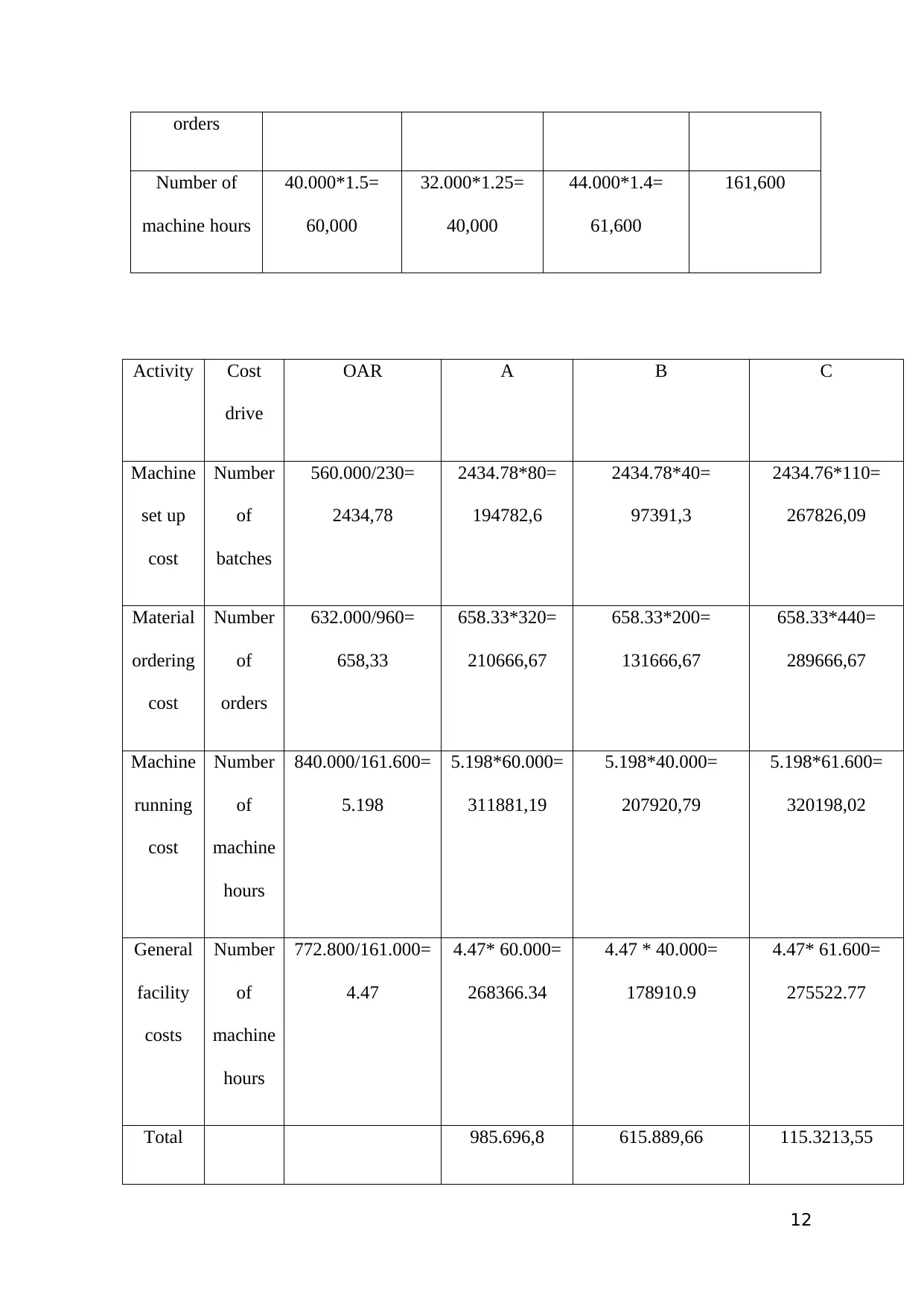
orders
Number of
machine hours
40.000*1.5=
60,000
32.000*1.25=
40,000
44.000*1.4=
61,600
161,600
Activity Cost
drive
OAR A B C
Machine
set up
cost
Number
of
batches
560.000/230=
2434,78
2434.78*80=
194782,6
2434.78*40=
97391,3
2434.76*110=
267826,09
Material
ordering
cost
Number
of
orders
632.000/960=
658,33
658.33*320=
210666,67
658.33*200=
131666,67
658.33*440=
289666,67
Machine
running
cost
Number
of
machine
hours
840.000/161.600=
5.198
5.198*60.000=
311881,19
5.198*40.000=
207920,79
5.198*61.600=
320198,02
General
facility
costs
Number
of
machine
hours
772.800/161.000=
4.47
4.47* 60.000=
268366.34
4.47 * 40.000=
178910.9
4.47* 61.600=
275522.77
Total 985.696,8 615.889,66 115.3213,55
12
Number of
machine hours
40.000*1.5=
60,000
32.000*1.25=
40,000
44.000*1.4=
61,600
161,600
Activity Cost
drive
OAR A B C
Machine
set up
cost
Number
of
batches
560.000/230=
2434,78
2434.78*80=
194782,6
2434.78*40=
97391,3
2434.76*110=
267826,09
Material
ordering
cost
Number
of
orders
632.000/960=
658,33
658.33*320=
210666,67
658.33*200=
131666,67
658.33*440=
289666,67
Machine
running
cost
Number
of
machine
hours
840.000/161.600=
5.198
5.198*60.000=
311881,19
5.198*40.000=
207920,79
5.198*61.600=
320198,02
General
facility
costs
Number
of
machine
hours
772.800/161.000=
4.47
4.47* 60.000=
268366.34
4.47 * 40.000=
178910.9
4.47* 61.600=
275522.77
Total 985.696,8 615.889,66 115.3213,55
12
⊘ This is a preview!⊘
Do you want full access?
Subscribe today to unlock all pages.

Trusted by 1+ million students worldwide
1 out of 25
Related Documents
Your All-in-One AI-Powered Toolkit for Academic Success.
+13062052269
info@desklib.com
Available 24*7 on WhatsApp / Email
![[object Object]](/_next/static/media/star-bottom.7253800d.svg)
Unlock your academic potential
Copyright © 2020–2025 A2Z Services. All Rights Reserved. Developed and managed by ZUCOL.





